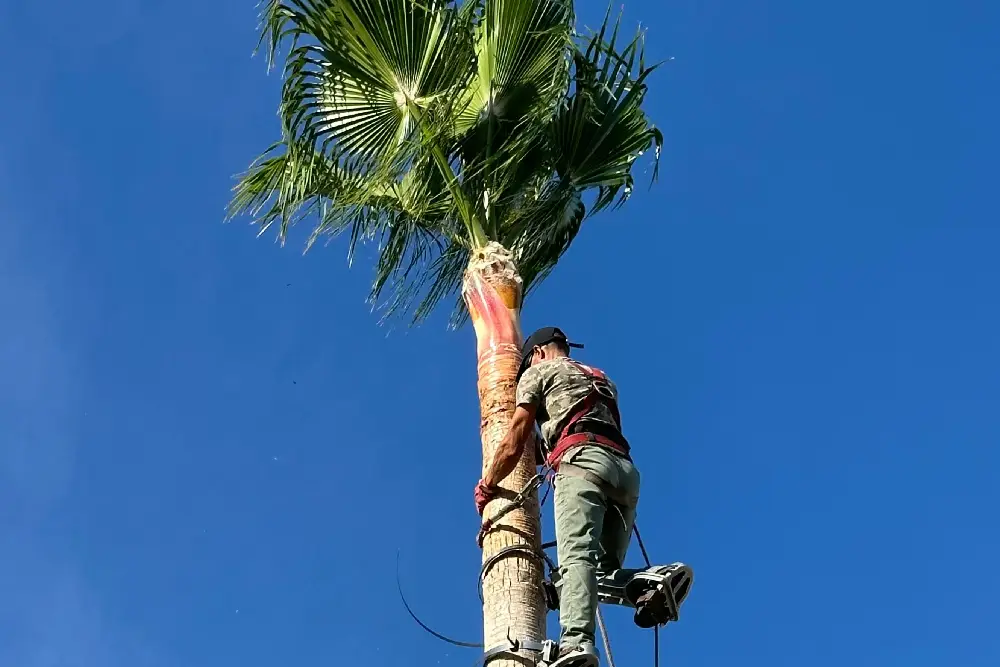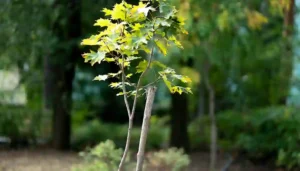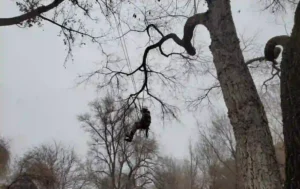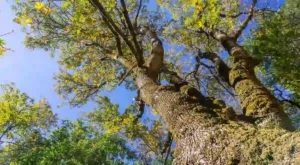The typical palm tree trimming cost can range between between $75 and $450 per tree, depending on height, variety and labor. Little palm trees are cheaper, but tall or difficult to access trees require additional time and equipment.
Jobs can run higher if there are a lot of dead fronds or the location is difficult to access. To find out more about tree trimming costs, read the following where we guide you through palm tree trimming costs..
Palm Tree Trimming Cost
Palm tree trimming costs vary depending on tree height, type, condition and service level. Worldwide, palm tree trimming jobs average $100-$650 a tree. Following are some general prices for top types of palm trees (also known as arecaceae) to help you plan and budget for palm care, regardless of where you live.
- Canary Island Date Palm: $250–$600 per trim
- Queen Palm: $100–$350 per trim
- Mexican Fan Palm: $75–$350 per trim
- Royal Palm: $150–$450 per trim
- Sago Palm (smaller palms): $50–$150 per trim
- Emergency trimming: $150–$250 per hour
Emergency services and additional work, such as seed pod removal or climbing, can drive costs into the hundreds above $600.
1. By Tree Height
Palm tree height is a primary cost factor. Most small palms under 4.5m cost $50 to $200 to trim. Medium palms, 4.5-9 meters, run about $75 to $400. For tall palms over 9 meters, prices can be $150 to $900 or more. These tasks require additional equipment and safety measures that increase the cost.
Taller trees = more hours, more risk, often a crew with lifts or ropes. That’s why a 12m royal palm tree in a city park costs a heck of a lot more to trim than a 3m sago palm in your yard. Small palms, on the other hand, are faster and more secure to access — keeping costs down.
2. By Tree Type
Certain palms are more expensive to trim. Queen palms and Mexican fan palms are very common so their prices are lower. Canary Island date palms and royal palms, with dense crowns and thick trunks, require additional care and expertise.
Rare/exotic types frequently require specialized equipment or expertise, and tree professionals might charge additional fees for the liability. Tree form and health also count. A neglected, overgrown palm or one with disease can double the cost.
For instance, a queen palm with old, dry fronds is less expensive to trim than a sick or bug-infested date palm.
3. By Service Level
Basic trimming is simply removing dead or dying fronds. That’s the best deal. Include services—such as seed pod removal, debris haul away, or stump grinding—and you could be paying $600 +. Cleanup is a major factor, especially if you live in a city with high dump fees.
Doing it yourself saves cash, but let’s be honest — most of us call in the experts for towering or complicated palms. Certain companies provide deals if you have multiple trees. This may lower the cost per tree, making it an ideal option for estate owners with numerous palms.
4. By Location
What trees are easy to get to cost less. Palms adjacent to a road or open yard are fast to trim. Trees next to power lines or surrounded by buildings require delicate attention, which is more expensive.
A palm’s health is another factor. A fragile or impaired tree might require special attention or equipment, increasing the cost. Hauling away fronds and seed pods is not always included in the base fee. Picking up the palm tree debris like fronds, bark, trunks and branches can add $50-$100 or more.
Make sure you consult on local ordinances before your next palm tree job. You may require a permit or could incur other costs to trim trees. The cost of palm tree trimming can be from $75 to $450 per tree depending on height, species and the level of labor involved.
What Influences Palm Tree Trimming Costs
Palm tree trimming prices are influenced by multiple factors. As well as the palm’s size and height, accessibility and the tree’s health are all key. Local rules, junk removal, and the team’s expertise play a part. Any of these can shift the price, sometimes a lot.
Tree Accessibility
Trees located close to houses, fences or electric wires may incur extra fees – crews could require cranes, lifts, or climbing gear and the extra costs can contribute to labour and equipment costs. If a palm is located in a tight area or heavily vegetated garden, the workers may spend more time working just to get to the tree and the costs will reflect that.
For instance, in city gardens, tight paths or adjacent structures can translate to elevated invoices. Conversely, palm trees in open yards with wide access generally cost less to trim. When trucks and tools get near, crews hustle, and less specialty equipment is required.
In certain areas, simple availability can reduce labor charges by a huge percentage, thus making the service more cost-effective. If the palm is difficult to access due to walls, steep slopes, or tight corners, additional logistical and man hours are required. Every extra trouble can push the price, sometimes by 20% or more.
Tree Health
Unhealthy or diseased palm trees typically require additional maintenance, and that translates to increased expenses. Dead fronds, rotten trunks or pest holes can really drag a job down because it has to be treated carefully to not cause additional damage or spread disease.
More time and effort are involved with these jobs, and special treatments are sometimes required. For instance, there may be additional fees for pruning infected fronds or treating the tree. A professional tree health check helps establish a reasonable price.
If the tree is in decline, a professional arborist could recommend additional measures, such as nutrient treatments or disease management. These services are not always part of standard trimming, so they increase the total price.
Debris Removal
Once trimmed, you’ve got all those cut fronds and branches to clean up! Big palms will fill an entire truck with debris, causing increased disposal costs. Some services include cleanup in their base price, others charge per load or by weight.
Bundling trimming with cleanup typically saves money, particularly if you have multiple trees. After all, bigger palms generally mean a pricier removal, occasionally accounting for 30% of the entire invoice. Always inquire whether cleanup is included in the quote, because surprise cleanup fees can really add up quickly.
Local Regulations
A number of communities have their own guidelines for tree trimming, and some even require permits. Disobeying these laws can mean fines, which adds to expenses. Regulated experts understand the laws and prevent you from getting into legal hot water.
Permits may be required if a tree is adjacent to power lines or in public areas. This can bog down the project and add fees, but it keeps your trimming above board and safe.
Certified teams are insured – meaning you’re protected from damage or accidents. Although hiring pros can be more expensive, it saves you from bigger issues down the road.
The Hidden Value of Professional Service
Professional tree trimming isn’t just about pruning dead leaves and fronds from a tree, it’s a profession that involves a host of skills, tools, and safety procedures. If you hire a certified arborist, your worries will fade, money will be saved in the long term, and there will be a guarantee of the tree’s healthy state.
Certified Arborist
An arborist will know how to detect disease, when to properly prune in the right season, and will keep your palm healthy with precision cuts. They utilize appropriate instruments such as sterilized pruning saws, pole trimmers and lifts for lofty branches of tall trees, which prevents infection transmission.
Pros know the difference between a clean cut and a bad one, and can detect early signs of rot or pest issues. If the improper tools are applied, fronds can split and bark torn, rendering the palm more susceptible to illness or death. By employing a specialist, you circumvent the need to purchase or rent equipment, which can be expensive, particularly for large palms.
Proper Equipment
The right tools make the work secure and effective. Qualified arborists use gear that allows them to ascend securely, like climbing harnesses and aerial lifts, and wield chain saws equipped with safety mechanisms. Most likely, you will not have these types of these tools, and they are expensive if you have to purchase them yourself.
Hacksaws and machetes can lead to accidents or tree scarring when trimming a tall palm. If you employ a service, you’re not only paying for their labor, but for the utilization of their machinery. This equates to less risk for you and less likelihood of requiring expensive repairs down the road.
Liability Insurance
Insurance is non-negotiable for tree work. If a branch falls on a neighbor’s car or a worker gets injured, liability insurance takes care of those expenses. Hiring an insured pro means you’re covered if something goes awry.
Most bargain or unlicensed services omit this, exposing you to either lawsuits or pricey patches. Insurance proves the company complies with industry regulations, which can increase your confidence in their services.
Long-Term Health
Regular pruning by the experts keeps palms strong and looking great. Neglect or poor cuts can stress a tree and result in costly removals. Healthy palms increase curb appeal and even add to property value.
Putting money into professional service keeps your trees final worth longer.
DIY Palm Trimming Cost
DIY palm tree trimming costs more than just service fees. You need the appropriate equipment and safety equipment, and a realistic eye on your time and dangers. The initial and maintenance cost, plus the labor and danger associated should be the impetus behind your determination.
Tool Investment
Palm tree trimming requires special tools. At the very least you require a tree-trimming saw, gloves, safety goggles and a robust ladder. For mature or tall palms, a chainsaw or pole saw is often required, particularly for those gnarly overgrown fronds that are difficult to trim.
Chainsaws can cost $40 to $60 a day to rent or $120 to $300 for a new one. Safety gear, like gloves and helmets, tack on another $25 to $50. If you’re going to be trimming regularly, quality equipment makes sense. You sidestep those continual rental fees and guarantee you’ve got the proper equipment available.
Tools require upkeep— blades go dull and chains wear out and safety gear deteriorates. Anticipate $20–$50 more per year for maintenance. For those trimming every 3-5 years, as suggested, this investment can pay off over time, particularly if you’re blessed with a few trees. Against $185 – $1,215 per tree for the professional guys, DIY starts to look appealing for a multi-tree or repeat job.
The Time Commitment
There is no way around it, trimming just a palm tree is not a fast process. For example, a small palm may take 1-2 hours to trim, a large tree may take a half day or more. As trees grow taller (over 6 feet) they become much more complicated and will require more time as you will most likely be moving your ladders around and also will have to carefully consider every cut for safety.
After you trim a palm tree, you will then have to consider the time needed to either clean up the debris and also fronds for disposal, which may take an additional hour or two depending on your local disposal regulations. Once you have a full time job and other commitments, it can be tough to find a free chunk of time to complete the project on the weekend. As scheduling conflicts usually will extend the project longer than originally planned.
The Risks
Using a ladder or a chainsaw without any training can be dangerous. Falls, cuts and electrocuted (if you happen to be near power lines) are all legitimate risks associated with trimming palms. Palm trees themselves are heavy and awkward which can cause you to inadvertantly harm other property – damaging cars, roofs or fences is a consequence if you drop a branch the wrong way.
Injuries like these could lead to hospital bills that exceed any money saved from your Check so you have to ask yourself if it is really worth it? If you were to make an insurance claim due to
Timing and Frequency
The ideal time to trim palm trees is in dry, mild weather — typically late spring or early summer, when the chance of disease is minimal. Brown, drooping fronds or visible fruit stalks are indications that a palm is in need of trimming.
Routine pruning, every 3-5 years, keeps growth manageable and less work. In wet or rainy climates, it takes some additional care to prevent mold after trimming.
When To Trim Palm Trees
When it’s time to trim palm trees timing is important. The right time is a combination of climate, tree type, health, and local condition. Often late winter and early spring is best but most professionals agree there come times when seasons may make more sense.
Palm tree owners should pay attention to the cycles of growth of the tree and also learn the signs to see when they need to take action!
Seasonal Timing
Dead or brown fronds hanging down are an obvious indication your palm tree is due for a trim. These ancient fronds can be a danger not only by their appearance, but if you live in a windy locale. If you notice seed pods starting to form, that’s an additional clue–time to trim before they fall and cause mess or sprout un-desired seedlings.
If you allow fronds to accumulate, they can obstruct sunlight, vistas, or pathways. This happens all the time for our residential and commercial customers. When your palm tree starts to look brown, shaggy and droopy, it’s best to to prune it so it looks good and stays healthy.
A trimmed palm is straighter and cleaner looking and can increase property value!
Visual Cues
By reviewing the species and age of your palm, you can establish a schedule-trimming frequency. Some species, such as Queen palms, are fast growers, requiring attention every 6 months. Slower growers, such as Date palms, may require yearly or longer intervals.
As for the care of smaller and/or younger palms, this usually does not take as much work. Conversely, older palms that have larger, crown-growing fronds, typically require more work. Health of the tree matters. An unhealthy or stressed trees likely will require less trimming, mainly to alleviate stress.
Routine care can mitigate the fronds from stacking, reducing more expensive, emergency trimming costs, post-storms or spurts of new growth.
Frequency
Most palm owners can get away with trimming one or two times a year, with some doing it every six months. For most species, one time per year is adequate. This all really depends on your local weather and tree growth.
If you live in an area that gets lots of storms, it’s probably a good idea to trim before hurricane season so that falling fronds can’t cause damage. Do not over-trim when pruning palms, and over-trimming anything other than dead fronds, especially healthy green fronds, can stress them and cause damage.
If someone tells you to trim or remove green fronds, get a second opinion. A palm, just like any plant, needs leaves for food.
Weather Considerations
Before you trim, check local restrictions. And, be sure to check the weather to see If heavy rain or storms are possible. If the weather looks dicey, best wait until it’s safe. Another tip is trim palm trees in the cool dry months. This makes disease less likely, which is why a lot of people opt for late winter or early spring.
Hot humid weather can stress the tree and wet seasons may spread pests or fungus following trimming.
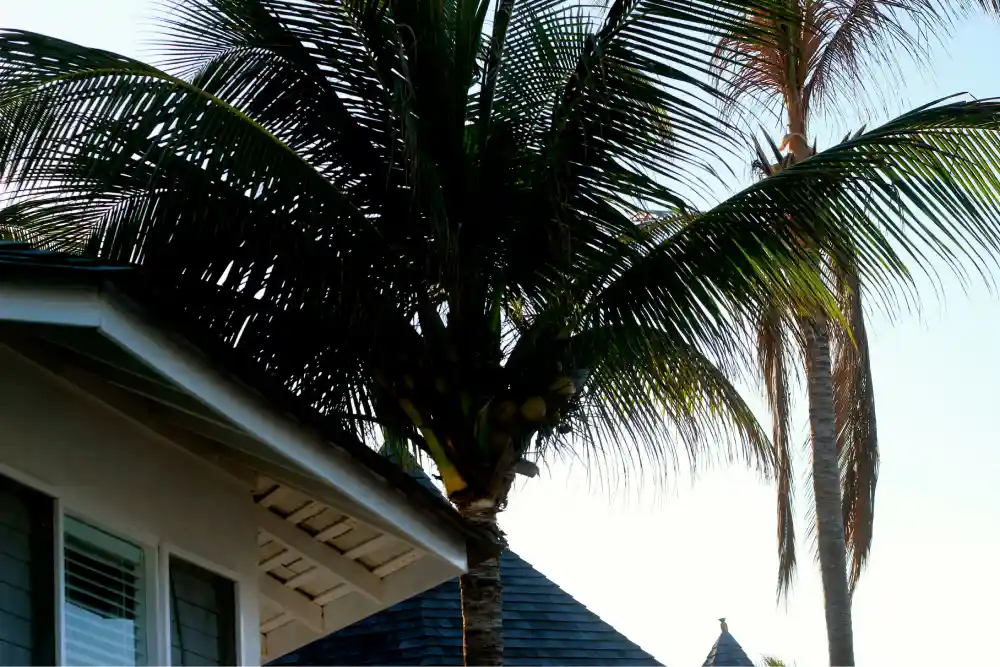
How To Get Accurate Quotes For Palm Tree Trimming
When determining how much does palm tree trimming cost, knowing how to get an accurate quote is important for anyone needing a palm tree trim. Pricing will vary greatly by the work to be done, so it’s good to break out what you will need and shop around a bit before you dive in.
To begin with, let’s look at what tools will be needed for the job. Most palm tree trimming processes will require pruning shears, hand saws, pole saws, ladders, safety harnesses, gloves and chainsaws if the trees are large. Each tool costs, and the cost will vary by quality, where you get it, and some may not cost a penny.
For example, a good pole saw may cost $70-$150, but you can rent that same tool for as little as $10-$20 for the day. Take some time to search for what local suppliers are pricing the tools at to give you an idea of the extremes of the costs involved.
If you’re not trimming trees frequently, renting could be the wiser option. Renting minimizes upfront costs, which is great for individuals that just want to trim a few trees a year. For example, renting a ladder or chainsaw for a one-off job is way less than buying them, which can save you a ton of cash if you don’t plan on using them all that often.
If you have multiple palms or intend to trim trees every season, owning your own trimmers could pay off in the long run. They really add up when you include recurring rental or service fees.
If you’re hiring a pro, having three estimates is a surefire way to save. Research reveals that shopping quotes between providers can reduce expenses by as much as 40%. Provide clear detailed information about your job.
Specify the variety of palm, its height and spread, and if you require special care, such as seed pod removal or shaping. Inquire with each provider whether their quote covers all fees. These providers may have setup fees, minimum hourly charges or surcharges for emergency service.
These can drive the cost significantly higher, with projects spanning from $50 for a small palm to $1,700 for tall or inaccessible trees. Comparing what each quote includes is just as important as the cost.
Verify what services are covered, and inquire about hidden fees. This aids you in selecting optimal value and provides you with peace-of-mind about what you are paying for.
Wrapping it Up – Palm Tree Trimming 101
Small palms in your yard are usually cheaper than those big, tall trees by the power lines! Equipment, equipment, and experience all alter the cost as well.
Hiring a pro keeps the job safe and neat, but doing it yourself means purchasing or renting equipment and spending hours.
Timing is everything–trim every year, or at least as soon as dead fronds appear. For best value, get a few local tree pros for transparent quotes and see what each includes. Transparent pricing means no guesswork or surprise invoices. Be tree- and budget-wise!
Frequently Asked Questions
How much does palm tree trimming usually cost?
We have found that palm tree trimming prices range from $50 – $300 per tree. Of course, it all depends on the palm tree height, its location and the condition of the palm.
What factors affect the price of palm tree trimming?
Things we look at to come up with a price are palm tree height, trunk diameter, location, and amount of trimming required. Accessibility and local labor costs factor in, too.
Is it cheaper to trim palm trees yourself?
Sure, DIY trimming cuts down on labor, but you need the proper tools and safety equipment. The article above lists costs for some of the tools needed to trim a palm tree. Make sure you factor in the risks and hidden costs, because they can build quickly.
How frequently should palm trees be trimmed?
Many palm trees will require trimming on an annual or bi-annual basis. Some palm tree species such as queen palms, may require additional attention to keep them a beautiful, healthy, and safe palm tree.
Why use a professional for tree trimming?
Professionals have the safety, techniques, and tree health requirements at the forefront of their work. Quality professionals have been trained in a variety of tree diseases and pests and will be able to treat or identify any issues with your palm tree.
Can trimming palm trees at the wrong time of year harm them?
Yes, if you trim a palm tree at the wrong time, like too hot or too cold of day or season, it could stress the tree and make it more possible to get disease or pest infestation.
What’s the best way to get an accurate palm tree trimming quote?
Reach out to two or three local palm tree care companies. Let them take a look at your trees (species, height, location) and have them generate their own accurate estimates.
